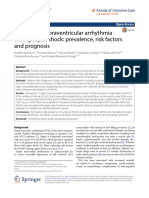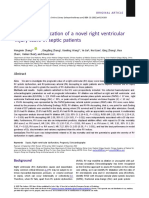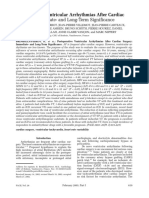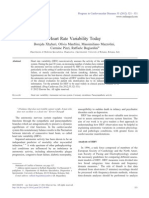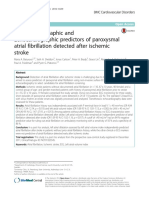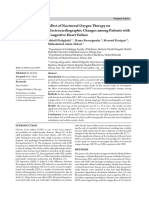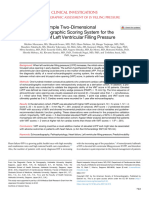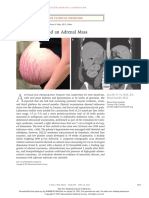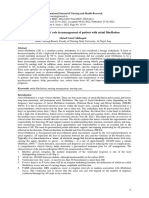Relationship Between Ventricular Rate Variability in Nonsustained Ventricular Tachycardia and Subsequent Cardiac Events
Relationship Between Ventricular Rate Variability in Nonsustained Ventricular Tachycardia and Subsequent Cardiac Events
Uploaded by
RobertoCopyright:
Available Formats
Relationship Between Ventricular Rate Variability in Nonsustained Ventricular Tachycardia and Subsequent Cardiac Events
Relationship Between Ventricular Rate Variability in Nonsustained Ventricular Tachycardia and Subsequent Cardiac Events
Uploaded by
RobertoOriginal Title
Copyright
Available Formats
Share this document
Did you find this document useful?
Is this content inappropriate?
Copyright:
Available Formats
Relationship Between Ventricular Rate Variability in Nonsustained Ventricular Tachycardia and Subsequent Cardiac Events
Relationship Between Ventricular Rate Variability in Nonsustained Ventricular Tachycardia and Subsequent Cardiac Events
Uploaded by
RobertoCopyright:
Available Formats
Relationship Between Ventricular Rate Variability in Nonsustained Ventricular Tachycardia and Subsequent Cardiac Events
Andrzej D?browski, M.D., and Ryszard Piotrowicz, M.D.
From the Department of Cardiology, Central Clinical Hospital M.M.A., Warsaw, Poland
Background: Clinical and experimental observations indicate that reduced beat-to-beat changes in the cycle length of nonsustained ventricular tachycardia (NSVT) may portend malignant ventricular tachyarrhythmias and sudden cardiac death. The purpose of the study was to test the hypothesis that measures of ventricular rate variability during NSVT (VRV-NSVT) may be useful in identifying patients at high risk of life-threatening arrhythmic events. Methods: The study group consisted of 326 patients who had NSVT on 24-hour ECG recordings. Temporal changes in up to 10 beat-to-beat intervals of NSVT runs (V-V) were assessed. The following parameters of VRV-NSVT were calculated: (1) average value of successive differences in V-V intervals (ADVV); and (2) normalized average value of successive differences in V-V intervals (nADVV). Results: During a mean follow-up of 4 years, 52 (16%) patients had a documented episode of sustained VT or ventricular fibrillation. Patients with these arrhythmic events had significantly (P < 0.001) lower values of ADVV and nADVV variables in comparison to patients without arrhythmic events. The relative risk of malignant arrhythmic events for patients with ADVV < 40 ms was 4.9 (P < 0.001), for patients with nADVV < 6%, the risk was 3.9 (P < 0.001). Conclusions: The results of this study indicate a strong and significant relationship between NSVT and the risk of subsequent malignant ventricular tachycardia. The assessment of VRV-NSVT may be useful for identifying patients at high and low risk for subsequent arrhythrnic events. A.N.E. 1996;1(1):27-32
heart rate variability; ventricular rhythm variability; nonsustained ventricular tachycardia; arrhythmic events
Nonsustained ventricular tachycardia (NSVT) occurs in normal persons and in a variety of heart A major and still unsolved clinical problem in patients with NSVT is represented by the need for a clear definition of the prognostic significance of this arrhythmia. Identification of patients who are at increased risk for sustained VT or ventricular fibrillation remains a challenge. Clinical and experimental observation^^-^ indicate that reduced beat-to-beat changes in the cycle length of NSVT may portend lethal ventricular tachyarrhythmias and sudden cardiac death. Cycle length oscillations have been investigated before termination of reentry in experimental models of VT.6,7 increase in ventricular cycle length variaAn tions was observed immediately before spontaneous termination of sustained VT associated with
coronary artery disease.8 Duff et al. reported that increased beat-to-beat changes in tachycardia cycle length are presented before spontaneous termination of VT, either primary or induced by programmed ventricular stimulation. In context of the abovementioned data, we decided to quantitatively assess ventricular rhythm variability during NSVT. The present study was designed to define the characteristics of ventricular rate variability (VRV)in patients with NSVT, and to determine whether the evaluation of VRV in NSVT (VRV-NSVT)may be used to identify patients at high risk of malignant ventricular arrhythmias.
METHODS
The study group consisted of 326 patients who had NSVT on 24-hour ECG recordings. The mean
Address for reprints: Prof: Andrzej Dcbrowski, ul. Foksal 12/14, m. 14, 00-366 Warsaw, Poland. Fax: (48-22) 61-00-241.
27
28
A.N.E.
Jan. 1996
Vol. 1 , No. 1
Dgbrowski, et al.
VT Rhythm Variabilitj and Cardiac Events
Table 1 . Clinical Characteristics of Study Group
Status at entry Myocardial infarction Other heart diseases No heart disease LVEF < 40% Medications during follow-up Digitalis Beta blockers Antiarrhythmic drugs ACE inhibitors
162 (50%) 103 (32%) 61 (19%) 72 (22%)
32 (10%) 123 (38%) 102 (31%] 43 (13%)
ACE = angiotensin converting enzyme; LVEF = left ventricular ejection fraction.
rhythmic events if sustained VT or ventricular fibrillation episodes were recorded on Holter monitoring or standard ECG. The sensitivity and s.pecificity of ADVV and nADVV values for the prediction of arrhythmic events was computed for seven dichotomy points. On the basis of the estimation the point of optimal trade-off between sensitivity and specificity (values of sensitivity and specificity not < 60%) was selected. We compared the arrhythmic event incidence in the group of patients below the cutpoint (expected to be at high risk) and in the group of patients at or above it (expected to be at low risk).
Statistical Analysis
age of the patients was 53 i 14 years (range 1982 years). There were 253 men and 73 women. The clinical characteristics of patients enrolled in this study are shown in Table 1. Indications for Holter monitoring were the evaluation of symptoms potentially related to cardiac arrhythmias and the assessment of risk after myocardial infarction. In all patients the Holter monitoring was performed in an antiarrhythmic drug-free state. NSVT was defined as three or more repetitive ventricular premature beats at a rate of 100 beats/ min or more, lasting < 30 seconds with spontaneous termination. The frequency distribution of the length of NSVT runs are shown in Figure 1. Temporal changes in up to 10 beat-to-beat V-V intervals of NSVT were assessed. In the cases with frequent VT episodes, the longest NSVT was analyzed. The Holter recordings strips were read manually, our single observer was unaware of clinical data. The following parameters of HRV-VT were calculated: (1) average value of successive differences in V-V intervals (ADVV);and (2) normalized average value of successive differences in V-V intervals (nADVV)obtained by dividing the absolute value of ADVV by the mean duration of all calculated V-V intervals and expressed as the proportion of the mean V-V interval duration. Additionally, the prognostic significance of maximal difference between consecutive V-V intervals (MDVV) < 100 ms was assessed. Continuous variables were expressed as mean value and standard deviation as well as median value. Data from the two groups were compared by the Mann-Whitneys rank sum test. Nonparametric method was used because the ADVV and nADVV variables did not exhibit a normal distribution. Univariate analysis of categorical data between dichotomized groups was performed using the Chi-square test to assess, whether VIIV-NSVT variables could be considered as predictors of malignant ventricular arrhythmias. Differences were taken as significant at the P < 0.05 level. The effect of VRV-NSVT on the risk of arrhythmic events was expressed as the relative risk. The relative risk was calculated as the incidence of arrhythmic events among patients with a high level of the VRV-NSVT variable divided by the incidence
35 30
30.7
E 20 $
m
25
15 10 5
0
Follow-Up
The period of follow-up ranged from 1- 7 years (mean 4 years). Only two patients were lost to follow-up. Patients were considered to have the ar-
Number of beab! in episode of NSVT
Figure 1 . Distribution of the number of beats in the longest episode of nonsustained ventricular tachycardia (NSVr)in 326 patients.
A.N.E.
Jan. 1996
Vol. 1 , No. 1
Dabrowski, et al.
W Rhythm Variability a n d Cardiac Events
29
of arrhythmic events among patients with the low level of this variable. Sensitivity was defined as the proportion of patients expected to be at high risk (below the cutpoint of VRV-NSVT variable level) who had arrhythmic events in the total number of patients with arrhythmic events. Specificity was defined as the proportion of patients expected to be at low risk (above the cutpoint of VRV-NSVT variable level) without arrhythmic events in the total number of patients without arrhythmic events. Predictive value of a positive response was defined as the proportion of patients at high risk who had arrhythmic events in the total number of high risk patients. Predictive value of a negative response was defined as the proportion of patients at low risk without arrhythmic events in the total number of low risk patients.
less of the incidence of sudden death. In the group of 52 patients with arrhythmic events the mean values of ADVV and nADVV were 27.8 2 36.9 ms and 6.9% ? 8.7%, whereas in the group of 274 patients without arrhythmic events, the mean values of ADVV and nADVV were 67.7 2 68.4 ms (P < 0.001) and 14.3% _t 12.2% (P < 0.001), respectively. Median values of ADVV and nADVV were 16.7 ms and 4.1% in the group with arrhythmic events, and 36.2 ms and 10.8% in the group without arrhythmic events.
Prognostic Value of VRV-NSVT Variables
Receiver operator characteristic curves were constructed to evaluate the positive and negative values of ADVV and nADVV variables in predicting arrhythmic events (Fig. 2). A cutoff value of 40 ms for ADVV had 75% sensitivity and 69% specificity in discriminating between high risk and low risk patients with NSVT. A cutoff value of 6% for nADVV yielded less satisfactory sensitivity (60%)and higher value of specificity (81%).At all considered cutoff points the negative predictive values were excellent but positive predictive values were relatively low (Table 3). Greater positive predictive values were obtained when we applied the minimal values of cutoff points for ADVV and nADVV. The cutoff value of 10 ms for ADVV correctly identified as high risk 20 of 28 patients (71%), the cutoff of 2% for nADVV correctly identified 13 of 19 patients (68%).However, at these marginal cutoff points for ADVV and nADVV the values of sensitivity were low (38% and 25%, respectively). Prognostic value of MDVV < 100 ms was poor in comparison with ADVV and nADVV because of low specificity (30%).
RESULTS
Follow-Up
Of the 326 patients included in the study, 52 had documented runs of sustained VT (49 cases) or ventricular fibrillation (3 cases) during follow-up. The episodes of these arrhythmic events occurred in 30 (20%)postinfarction patients, in 13 (13%)patients with other organic heart diseases, and in 6 (8%) patients without apparent heart disease. Eighty-three patients (30%) in the group without arrhythmic events were receiving antiarrhythmic drugs during follow-up. In the group with arrhythmic events, the treatment with antiarrhythmic drugs was used in 19 patients (37%)before and in 50 patients (96%)after occurrence of arrhythmic events. Forty-eight of the 326 study patients died suddenly during observation, 13 in the group with arrhythmic events and 35 in the group without documented arrhythmic events.
DISCUSSION
A few available tests can be helpful in predicting malignant arrhythmic events in patients with NSVT. The presence of late potentials on the signalaveraged ECG have been shown to predict spontaneous sustained VT. However, this method has some limitations. Although it appears to have high negative predictive value, both its sensitivity and positive predictive value are 1 0 w . ' ~ - ' ~ Programmed ventricular stimulation can also be used to identify patients with NSVT who are at high risk for sustained VT in the f ~ t u r e . ' ~How-'~ ever, this invasive investigation is limited to spe-
VRV-NSVT in Patients With and Without Cardiac Events
In the group of 48 patients who died suddenly, and in the group of 39 patients with arrhythmic events but without sudden death, the mean values of ADVV as well as mean values of nADVV, were significantly (P < 0.001) lower than in the group of 239 uncomplicated patients (Table 2). Also, the major differences in VRV-NSVT were observed between the two groups separated with regard to occurrence of arrhythmic events, regard-
30
A.N.E.
Jan. 1996
Vol. 1 , No. 1
D+browski, et al.
VT Rhythm Variabilit). and Cardiac Events
Table 2. Ventricular Rate Variability in Patients With and Without Cardiac Events Parameters
ADW Mean i- SD (ms) Median (ms) Normalized ADW Mean t SD (%) Median (Yo)
Arrhythmic Event (n = 39) 27.1 i- 38.9 15.8
6.2 +- 8.1 3.6
Sudden Death
Uncomplicated Patients
(n
48)
(n
239)
34.8 2 37.9 18.7 7.8 t 7.3 3.1
74.7 -+ 68.8* 38.3 15.6 2 12.7* 12.3
Significant difference (P < 0.001) in relation t o respective values in groups of patients with arrhythmic events and patients with sudden deaths. ADW = average value of successive differences in cycle lengths of nonsustainod ventricular tachycardia.
cialized cardiology departments and cannot be used routinely in selecting high risk patients with NSVT. Recent ~tudies~-l indicate that sinus rate variability may be useful for identifying patients at increased risk for sudden death due to malignant ven-
0% J
0%
20%
40%
60%
80%
1 w
Specificity
nADW (%)
0%
4
0%
2036
40%
60%
80%
100%
Specificity
Figure 2. Sensitivity and specificity relation of varied absolute (panel A) and normalized (panel B) average differences between consecutive V-V intervals in predicting arrhythmic events. Dichotomy points selected for relative risk calculation are marked by arrows.
tricular arrhythmias. The accuracy of this method based on analysis of sinu.5 heart rate variability is largely dependent on the accuracy and quality of the evaluated data. Thus, this method may not be applied to patients with unanalyzable electrocardiographic recordings because of high noise level, beat misrecognition artifacts, pacemaker rhythm, and frequent supraventricular rhythms other than sinus rhythm on the 24-hour ECG. Additionally, this method may not be u:jed in patients with bundle branch block or pre -excitation syndrome in whom the wide QRS coniplexes may disturb the computer analysis of the 24-hour sinus rhythm variability. All these tests appear to have limited prognostic significance in patients wi:hout apparent heart disease and in patients with other than myocardial infarction types of organic heart disease. Certain characteristics of NSVT may be able to identify patients at risk for future life-threatening arrhythmias. This opinion may be indirectly confirmed by results of previously repoi-ted studies.20,21 Characteristics of the VT preceding ventricular fibrillation indicated that ventricular .rhythm rate was usually high, and there was often an acceleration of the VT before ventricular fibrillation.21 In addition, Olsson et a1. reported that in patients with NSVT the occurrence of spontaneous sustained VT was observed in these patients who had a higher rate of NSVT. Also, the clinical value of coupling interval measurements has been recently emphasized. Trappe et al.23reported that coupling intervals of ventricular premature beats and couplets were significantly shorter in patients who died suddenly compared with survivors. Patients with coupling intervals of ventricular couplets < 500 ms died significantly earlier than those with coupling intervals
A.N.E.
Jan. 1996
Vol. 1 , No. 1
Dgbrowski, et al.
VT Rhythm Variability and Cardiac Events
31
Table 3. Prognostic Significance of Average Differences (ADW) and Maximal Differences (MDW)
in Consecutive Cycle Lengths of Nonsustained Ventricular Tachycardia
Arrhythmic Event n (Yo)
Parameters
Sn
75% 60% 90%
Sp
PrV+
31%
PrV-
Relative Risk
xz
35.9 38.1
P Value
ADW < 40 ms 2 40 ms
39/124 (31.4%) 13/202 (6.4%) 31/83 (37.4%) 21/243 (9.5%) 47/240 ( 1 9.6%] 5/86 (6.2%)
69% 81% 30%
93% 91%
4.9 3.9 3.2
<0.001 <0.001
Normalized ADW < 6%
2
37%
6%
MDW < 100ms >- l 0 0 m s
20%
94%
8.9
<0.01
Sn = sensitivity; Sp = specificity; PrV+ and PrV- = positive and negative predictive values, respectively.
> 500 m ~ . Olsson et a1." showed that spontane'~ ous sustained VT appeared in those patients who had a coupling interval of NSVT < 500 ms. In context of abovementioned data, it is reasonable that the Moss grading system of ventricular arrhythmias, currently used for risk stratification after myocardial infarction, includes estimation of morphology of repetitive ventricular b e a k z 4 According to this system certain electrocardiographic characteristics of NSVT (coupling interval < 300 ms, duration > 10 beatslmin at rate > 150/min, and torsades de pointes configuration) are called "malignant' ' and constitute a basis for assignation of ventricular arrhythmias to grade 4 of Moss classification. Results of our study clearly indicate that VRVNSVT should be considered as additional characteristic of repetitive ventricular beats, which may be helpful in selection of high risk patients with NSVT. The VRV-NSVT had a high negative predictive value, suggesting that no specific treatment appears needed if rhythm is markedly irregular, regardless of the presence of different noninvasive risk markers. Thus, the VRV-NSVT performs best when used to exclude risk of arrhythmic events rather than to identify high risk patients. This study was not designed to investigate the electrophysiological mechanism by which changes in cycle length can facilitate the termination of VT run. The short-long-short cardiac sequence has been shown to result in differential changes in refractoriness of His-Purkinje system and muscle fib e r ~ . ' ~ , ' ~ refractory period is dependent not The only on the cumulative effect of a large number of preceding cycle lengths, but also on the immedi-
ately preceding cycle The long cardiac cycle length is followed by prolonged refractoriness in ventricular myocardium and may extend into the arrhythmogenic zone. The sudden acceleration in the heart rate may cause conduction block and tachycardia termination if a new short cycle length exceeds the refractoriness of the previous long cycle length.
Limitations
This work should be considered a preliminary study since the cutpoints for the VRV-NSVT variables were made by retrospective data analysis to optimize their predictive value. Also, the independent predictive value of the variables was not assessed by multivariate analysis and that subsequent studies should be carried out to evaluate these questions. All recordings were made when the patients were free of antiarrhythmic drugs. In some patients the VRV-NSVT variables were probably influenced by antiarrhythmic therapy during follow-up. This was an uncontrolled study; thus, it is possible that the use of antiarrhythmic drugs influenced the arrhythmic event rate. In the group without arrhythmic events, 30% of patients were receiving antiarrhythmic drugs during follow-up, whereas in the group with arrhythmic events the treatment with antiarrhythmic drugs was applied in 37% of patients before arrhythmic event occurrence.
CONCLUSIONS
This is the first study to identify an association between VRV-NSVT and arrhythmic event occur-
32
A.N.E.
Jan. 1996
Vol. 1 , No. 1
Dgbrowski et al.
V Rhythm Variabillty and Cardiac Events T
rence in patients with NSVT. The data of this study strongly suggests that VRV-NSVT is a noninvasive and easy to perform method for the prediction of malignant arrhythmic events in patients with NSVT. Further studies are needed to determine if VRV-NSVT has value independent of other clinical variables such as ejection fraction, heart rate variability, late potentials, and rate and length of NSVT.
REFERENCES
1. Camm AJ, Evans KE, Ward DE, et al. The rhyhm of the heart in active elderly subjects. Am Heart J 1980; 99:598603. 2. Kennedy HL, Whitlock ]A, Sprague MK, et al. Long-term follow-up of asymptomatic healthy subjects with frequent and complex ventricular ectopy. N Engl J Med 1985; 312~193197. 3. Andersen KP, DeCamilla J, Moss AJ. Clinical significance of ventricular tachycardia (3 beats or longer) detected during ambulatory monitoring after myocardial infarction. Circulation 1978; 57:890-897. 4. McLenachan JM, Dargie HJ. Ventricular arrhythmias in hypertensive left ventricular hypertrophy. Am J Hypertens 1990; 31735-740. 5. Francis GS. Development of arrhythmias in the patients with congestive heart failure: Pathophysiology, prevalence and prognosis. Am J Cardiol 1986; 57iSuppl. B):3-7. 6. Callans DJ, Marchlinski FE. Characterization of spontaneous termination of sustained ventricular tachycardia associated with coronary artery disease. Am J Cardiol 1991; 6750-54. 7. El-Sherif N, Mebra R, Gough WB, et al. Reentrant ventricular arrhythmias in the late myocardial infarction period: Interruption of reentrant circuits by cryothermal techniques. Circulation 1983; 68:644-656. 8. Frame LH, Simson MB. Oscillations of conduction, action potential duration, and refractoriness. A mechanism for spontaneous termination of reentrant tachycardias. Circulation 1988; 78:1277- 1287. 9. Duff HJ, Mitchell LB, Gills AM, et al. Electrocardiographic correlates of spontaneous termination of ventricular tachycardia in patients with coronary artery disease. Circulation 1991; 8811054- 1062. 10. Simson MB. Use of signals in the terminal QRS complex to identify patients with ventricular tachycardia after myocardial infarction. Circulation 1981; 64:235-241. 11. Kuchar DL, Thornburn CW, Sammel NL. Late potentials detected after myocardial infarction: Natural history and prognostic significance. Circulation 1986; 74.1280- 1289. 12. Breithardt G, Cain ME, El-Sherif N, et al. Standards for
analysis of ventricular late potentials using high-resolution or signal-averaged electrocardiography. Circdation 1991; 83: 1481- 1488. 13. Buxton AE, Marchlinski ITE, Flores BT, et al. Nonsustained ventricular tachycardia in patients with coronary artery disease: Role of electrophysiologic study. Circulation 1987; 75:1178- 1185. 14. Klem RC, Machell C. Use of electrophysiologic testing in patients with nonsustained ventricular tachycardia: Prognostic and therapeutic implications. J Am Coll Cardiol 1989; 14:155- 161 15. Manolis AS, Estes NAM. Value of programmed ventricular stimulation in the evaluai ion and management of patients with nonsustaned ventricular tachycardia associated with coronary artery disease. Am J Cardiol 1990; 65:201-205. 16. Kleiger RE, Miller JP, Bigger JT, et al. Decreased heart rate variability and its association with increased mortality after acute myocardial infarction. Am J Cardiol 1987; 59:256262. 17. Malik M, Farrell T, Cripps T, et al. Heart rate variability in relation to prognosis after myocardial infarction: Selection of optimal processin,; techniques. Eur Heart J 1989; 10:1060- 1074. 18. Algra A, Tijssen JG, Roelaiidt JR, et al. Heart rate variability from 24-hour electrocardiography and the 2-year risk for sudden death. Circulation 1993; 88:180- 185. 19. Bigger JTH, Fleiss JL, Roinitzky LM, et al. The ability of several short-term measures of RR variability to predict mortality after myocardial infarction. Circulation 1993; 88:927-934. 20. Kempf FC, Josephson ME Cardiac arrest recorded on ambulatory electrocardiogram. Am J Cardiol 1984 53115771582. 21. Guindo J, Bayes de Luna A . Muerte subita en la cardiopatia isqueniica. Rev Esp Cardiol 1989; 42:116- 123. 22. Olsson G, Rehnqvist N. Ventricular arrhythmias during the first year after acute mycicardial infarction: Influence of long-term treatment with metoprolol. Circulation 1984; 69:i 129- 1134. 23. Trame HI, Wenzlaff P, Klein H. et al. Prognostic value of &e coipling interval of ventricular premature beats. J Electrophysiol 1988; 2127- 140. 24. Moss AJ. Prognosis after myocardial infarction. Am J Cardiol 1983; 52:667-699. 25. Denker S, Lehman N, Mahmud R, et al. Divergence between refractoriness of His-Purkinje system with abrupt changes in cycle length. Circulation 1983; 68:1212- 1221. 26. Wiener I, Kunkes S, Rubin I), et al. Effects of sudden change in cycle length on human abial, atrioventricular nodal, and ventricular refractory periods. Circulation 1981; 64: 245248. 27. Han J, Moe GK. Cumulative effects of cycle length on refractory period of cardiac: tissues. Am J Physiol 1969; 217~106109. 28. Janse MJ, Van der Steen AE, Van Dam RT, et al. Refractory period of the dog's ventricular myocardium following sudden changes in frequency. Circ Res 1969; 24:251-262.
You might also like
- Holter Contec TLC9803 User Manual - EnglishDocument53 pagesHolter Contec TLC9803 User Manual - EnglishEdward MoralesNo ratings yet
- Uw Step3 NotesDocument34 pagesUw Step3 NotesAakash ShahNo ratings yet
- Beginning Medical Transcription (2nd Ed.) : Cardiopulmonary Reports Ent and Ophthalmology ReportsDocument7 pagesBeginning Medical Transcription (2nd Ed.) : Cardiopulmonary Reports Ent and Ophthalmology ReportsRoderick RichardNo ratings yet
- Test - Mark Klimek Yellow Book (KV) - QuizletDocument62 pagesTest - Mark Klimek Yellow Book (KV) - QuizletRonelyn Rachelle CabcabanNo ratings yet
- High Prevalence of Left Ventricular Systolic and Diastolic Asynchrony in Patients With Congestive Heart Failure and Normal QRS DurationDocument8 pagesHigh Prevalence of Left Ventricular Systolic and Diastolic Asynchrony in Patients With Congestive Heart Failure and Normal QRS DurationVashish RamrechaNo ratings yet
- 07032501-Standard DDD PacingDocument3 pages07032501-Standard DDD PacingRobertoNo ratings yet
- 3.regression of Electrocardiographic Left VentricularDocument6 pages3.regression of Electrocardiographic Left VentricularGaal PinNo ratings yet
- Main 51 ???Document5 pagesMain 51 ???pokharelriwaj82No ratings yet
- DTI Superposition PDFDocument7 pagesDTI Superposition PDFEtel SilvaNo ratings yet
- 17 PDFDocument11 pages17 PDFruryNo ratings yet
- New-Onset Supraventricular Arrhythmia During Septic Shock: Prevalence, Risk Factors and PrognosisDocument8 pagesNew-Onset Supraventricular Arrhythmia During Septic Shock: Prevalence, Risk Factors and PrognosisAhmad FahroziNo ratings yet
- Lin 2009Document7 pagesLin 2009Nur Syamsiah MNo ratings yet
- A Simple Method For Noninvasive Estimation of Pulmonary Vascular ResistanceDocument7 pagesA Simple Method For Noninvasive Estimation of Pulmonary Vascular ResistanceJorge KlyverNo ratings yet
- JLM 03 26Document8 pagesJLM 03 26Roberto DianNo ratings yet
- Short-Term Heart Rate VariabilityDocument6 pagesShort-Term Heart Rate VariabilityMary Marlene Tarazona MolinaNo ratings yet
- YQVx Q47 XSBK 6 NCG 4 W 9 Ypp KRDocument6 pagesYQVx Q47 XSBK 6 NCG 4 W 9 Ypp KRRicardo MingireanovNo ratings yet
- Prognosis of PiDocument7 pagesPrognosis of PiGhea SugihartiNo ratings yet
- Prognostic Implication of A Novel Right Ventricular Injury Score in Septic PatientsDocument9 pagesPrognostic Implication of A Novel Right Ventricular Injury Score in Septic PatientsKorejat KDNo ratings yet
- 1785 FullDocument10 pages1785 FullAgustina 'tina' HartutiNo ratings yet
- ContentServer AspDocument9 pagesContentServer Aspganda gandaNo ratings yet
- Wa0046.Document5 pagesWa0046.PitoAdhiNo ratings yet
- Effect of Right Ventricular Function and Pulmonary Pressures On Heart Failure PrognosisDocument7 pagesEffect of Right Ventricular Function and Pulmonary Pressures On Heart Failure PrognosisMatthew MckenzieNo ratings yet
- T Wave Alternans For Ventricular Arrhythmia Risk StratificationDocument5 pagesT Wave Alternans For Ventricular Arrhythmia Risk StratificationSalim VelaniNo ratings yet
- HRV Rovere 901Document7 pagesHRV Rovere 901Luisa OsorioNo ratings yet
- 1 s2.0 S1110260814000040 MainDocument7 pages1 s2.0 S1110260814000040 MainCarmen Cuadros BeigesNo ratings yet
- Heart Rate Variability Today PDFDocument11 pagesHeart Rate Variability Today PDFVictor SmithNo ratings yet
- Evaluation of Cerebral Blood Flow Dynamics in Transient Ischemic Attacks Patients With Fast Cine Phase Contrast Magnetic Resonance AngiographyDocument6 pagesEvaluation of Cerebral Blood Flow Dynamics in Transient Ischemic Attacks Patients With Fast Cine Phase Contrast Magnetic Resonance AngiographySofía ValdésNo ratings yet
- Stroke Volume Variation As An Indicator of Fluid Responsiveness Using Pulse Contour Analysis in Mechanically Ventilated PatientsDocument4 pagesStroke Volume Variation As An Indicator of Fluid Responsiveness Using Pulse Contour Analysis in Mechanically Ventilated PatientserwanNo ratings yet
- Value of Red Blood Cell Distribution Width On Emergency Department Admission in Patients With Venous ThrombosisDocument6 pagesValue of Red Blood Cell Distribution Width On Emergency Department Admission in Patients With Venous ThrombosisJicko Street HooligansNo ratings yet
- Impact of Extraischemic Hemorrhage After Thrombolysis With Intravenous Recombinant Tissue Plasminogen ActivatorDocument5 pagesImpact of Extraischemic Hemorrhage After Thrombolysis With Intravenous Recombinant Tissue Plasminogen ActivatorSuciD.LestariTabrisNo ratings yet
- Sako 2011Document1 pageSako 2011Jake WilsonNo ratings yet
- Characterisig Triphasic, Biphasic and MonophasicDocument9 pagesCharacterisig Triphasic, Biphasic and Monophasicraviks34No ratings yet
- Review Artikel Blok 8Document5 pagesReview Artikel Blok 8ajikwaNo ratings yet
- Wesner - Anesthesia For Lower Extremity BypassDocument17 pagesWesner - Anesthesia For Lower Extremity BypassIbet Enriquez PalaciosNo ratings yet
- Does ThrombolysisDocument7 pagesDoes ThrombolysisNovendi RizkaNo ratings yet
- The Importance of Emergency Open Surgery For Ruptured Abdominal Aortic Aneurysms in A Single Center Retrospective StudyDocument7 pagesThe Importance of Emergency Open Surgery For Ruptured Abdominal Aortic Aneurysms in A Single Center Retrospective StudyScivision PublishersNo ratings yet
- Impaired Left Ventricular Apical Rotation Is Associated With Disease Activity of Psoriatic ArthritisDocument8 pagesImpaired Left Ventricular Apical Rotation Is Associated With Disease Activity of Psoriatic ArthritisEmanuel NavarreteNo ratings yet
- SVT Mayo 2008Document12 pagesSVT Mayo 2008muhanasNo ratings yet
- Electrocardiographic and Echocardiographic Predictors of Paroxysmal Atrial Fibrillation Detected After Ischemic StrokeDocument8 pagesElectrocardiographic and Echocardiographic Predictors of Paroxysmal Atrial Fibrillation Detected After Ischemic StrokeLuni HaniaNo ratings yet
- 1 s2.0 S0002914922005355 MainDocument11 pages1 s2.0 S0002914922005355 MainRamona GhengheaNo ratings yet
- Artikel SVTDocument17 pagesArtikel SVTbambang hermawanNo ratings yet
- Myocardial Contractile Dispersion: A New Marker For The Severity of Cirrhosis?Document5 pagesMyocardial Contractile Dispersion: A New Marker For The Severity of Cirrhosis?triNo ratings yet
- Jurnal OmiDocument14 pagesJurnal OmiYogie YahuiNo ratings yet
- Artigo 16Document8 pagesArtigo 16Gavin TexeirraNo ratings yet
- Wa0037.Document10 pagesWa0037.Jesus7RahNo ratings yet
- Neuro-Ultrasonography 2020Document15 pagesNeuro-Ultrasonography 2020Santiago PovedaNo ratings yet
- Samol2012 PDFDocument8 pagesSamol2012 PDFnaniro orinanNo ratings yet
- Obstructive + Restrictive DiseaseDocument5 pagesObstructive + Restrictive DiseaseJunaflor RomuloNo ratings yet
- 1 s2.0 073510979390668Q Main PDFDocument9 pages1 s2.0 073510979390668Q Main PDFPribac RamonaNo ratings yet
- International Journal of CardiologyDocument5 pagesInternational Journal of CardiologyDiah Kris AyuNo ratings yet
- Contribution of Speckle Tracking To Estimation of Pulmonary Hypertension by Standard Doppler Echocardiography in Patients With Sys 2161 1149 1000213Document5 pagesContribution of Speckle Tracking To Estimation of Pulmonary Hypertension by Standard Doppler Echocardiography in Patients With Sys 2161 1149 1000213a f indra pratamaNo ratings yet
- Journal - Pone.0081896 PredictionDocument14 pagesJournal - Pone.0081896 PredictionTowfeeq FerozNo ratings yet
- Archive of SID: New Correlation Between Angles of Wide Qrs Complex in Electrocardiogram and Echocardiographic IndicesDocument4 pagesArchive of SID: New Correlation Between Angles of Wide Qrs Complex in Electrocardiogram and Echocardiographic IndicesВиктор БебенинNo ratings yet
- Lvedp in AmiDocument3 pagesLvedp in AmiFaisol SiddiqNo ratings yet
- Jurnal InternalDocument10 pagesJurnal InternalseptikusumaNo ratings yet
- Duplex Ultrasound Screening Detects High Rates of Deep Vein Thromboses in Critically Ill Trauma PatientsDocument6 pagesDuplex Ultrasound Screening Detects High Rates of Deep Vein Thromboses in Critically Ill Trauma PatientsCourtneykdNo ratings yet
- Quantification Asynchhrony Last REv 03 2008 Reordenando AntDocument20 pagesQuantification Asynchhrony Last REv 03 2008 Reordenando AntEtel SilvaNo ratings yet
- RVF in ArdsDocument8 pagesRVF in ArdsAshish PandeyNo ratings yet
- Effect of Nocturnal Oxygen Therapy On Electrocardiographic Changes Among Patients With Congestive Heart FailureDocument3 pagesEffect of Nocturnal Oxygen Therapy On Electrocardiographic Changes Among Patients With Congestive Heart FailureNurAfifahNo ratings yet
- 1 s2.0 S0894731721000882 MainDocument12 pages1 s2.0 S0894731721000882 MainSuryati HusinNo ratings yet
- 2014-08-03 09.09.53 6Document9 pages2014-08-03 09.09.53 6Nag Mallesh RaoNo ratings yet
- The Ultimate Guide to Vascular Ultrasound: Diagnosing and Understanding Vascular ConditionsFrom EverandThe Ultimate Guide to Vascular Ultrasound: Diagnosing and Understanding Vascular ConditionsNo ratings yet
- Estrias. Cushing.Document1 pageEstrias. Cushing.RobertoNo ratings yet
- Tromboembolismo en La LenguaDocument1 pageTromboembolismo en La LenguaRobertoNo ratings yet
- Takamine1902. Paper AdrenalinaDocument3 pagesTakamine1902. Paper AdrenalinaRobertoNo ratings yet
- SalDocument8 pagesSalRobertoNo ratings yet
- Urinary Sodium Excretion, Blood Pressure, Cardiovascular Disease, and Mortality: A Community-Level Prospective Epidemiological Cohort StudyDocument11 pagesUrinary Sodium Excretion, Blood Pressure, Cardiovascular Disease, and Mortality: A Community-Level Prospective Epidemiological Cohort StudyRobertoNo ratings yet
- A Complete Electrical Shock Hazard Classification System and Its ApplicationDocument13 pagesA Complete Electrical Shock Hazard Classification System and Its ApplicationRajuNo ratings yet
- Salome vs. ECC PDFDocument5 pagesSalome vs. ECC PDFColeen ReyesNo ratings yet
- Electrical SafetyDocument18 pagesElectrical Safetyオマル カジサジャNo ratings yet
- PVC Unido ConDuplicadosDocument1,181 pagesPVC Unido ConDuplicadosJorge Chachaima MarNo ratings yet
- MEDICAL SURGICAL NURSING Cardiovascular and Respiratory SystemDocument12 pagesMEDICAL SURGICAL NURSING Cardiovascular and Respiratory Systemvalentine95% (20)
- Electrical Shock Hazards and Safety Codes For Electromedical EquipmentsDocument19 pagesElectrical Shock Hazards and Safety Codes For Electromedical EquipmentsRaghav GuptaNo ratings yet
- Ecg Interpretation in The Critically Ill Dog and Cat PDFDocument166 pagesEcg Interpretation in The Critically Ill Dog and Cat PDFaleynavardar2010No ratings yet
- The Lazarus PhenomenonDocument6 pagesThe Lazarus PhenomenonCarlos Emilio RTNo ratings yet
- CPR Manual 2016 New Officers Final 3 1 PDFDocument48 pagesCPR Manual 2016 New Officers Final 3 1 PDFRj Polvorosa100% (2)
- Department of Brain Repair & RehabilitationDocument23 pagesDepartment of Brain Repair & Rehabilitationkuruvagadda sagarNo ratings yet
- Goldberger AL, West BJ. (1987) Fractals in Physiology and MedicineDocument14 pagesGoldberger AL, West BJ. (1987) Fractals in Physiology and MedicineMitchellSNo ratings yet
- DefibrillatorDocument22 pagesDefibrillatorDhvij KmlNo ratings yet
- Nursing Board Exam Review Questions in Emergency Part 6/20Document15 pagesNursing Board Exam Review Questions in Emergency Part 6/20Tyron Rigor Silos100% (5)
- Life Threatening Rhythm: Presenter: Muhammad Najmuddin Bin Hussain 2. Wan Muhammad Nasirudin Bin Wan YusoffDocument17 pagesLife Threatening Rhythm: Presenter: Muhammad Najmuddin Bin Hussain 2. Wan Muhammad Nasirudin Bin Wan YusoffWan NasirudinNo ratings yet
- Cardiac ArrestDocument30 pagesCardiac ArrestTommy NainggolanNo ratings yet
- Exam1 100731100921 Phpapp02Document34 pagesExam1 100731100921 Phpapp02Yaj CruzadaNo ratings yet
- User Manual For Ios: Alivecor® Mobile EcgDocument27 pagesUser Manual For Ios: Alivecor® Mobile EcgKaranNo ratings yet
- Overview of Nurses' Role in Management of Patient With Atrial FibrillationDocument5 pagesOverview of Nurses' Role in Management of Patient With Atrial FibrillationAhmed AlkhaqaniNo ratings yet
- Hypertension and Cardiac Arrhythmias A Consensus Document From The Ehra and Esc Council On Hypertension Endorsed by Hrs Aphrs and SoleaceDocument21 pagesHypertension and Cardiac Arrhythmias A Consensus Document From The Ehra and Esc Council On Hypertension Endorsed by Hrs Aphrs and SoleaceDaimon MichikoNo ratings yet
- PALS Nitty Gritty Study Guide FINALDocument11 pagesPALS Nitty Gritty Study Guide FINALuncmikee1997100% (1)
- Jama Kamel 2024 Oi 230163 1706898479.89128Document9 pagesJama Kamel 2024 Oi 230163 1706898479.89128Srinivas PingaliNo ratings yet
- Contec TLC9803 Dynamic ECG SystemDocument2 pagesContec TLC9803 Dynamic ECG Systemyoucef BallaNo ratings yet
- K - 7 Atrial Flutter (IKA)Document8 pagesK - 7 Atrial Flutter (IKA)thomasfelixNo ratings yet
- Dte-1 Lab RecordDocument85 pagesDte-1 Lab Recordpraveena raviNo ratings yet
- Clinical Case Study - Online Discussion Form Fall 2020-1Document14 pagesClinical Case Study - Online Discussion Form Fall 2020-1Sabrina Odies100% (1)
- Electrical InjuriesDocument1 pageElectrical InjuriesIkhwan SalamNo ratings yet
- Asystole: Ventricular FibrillationDocument3 pagesAsystole: Ventricular FibrillationLucia CorlatNo ratings yet










